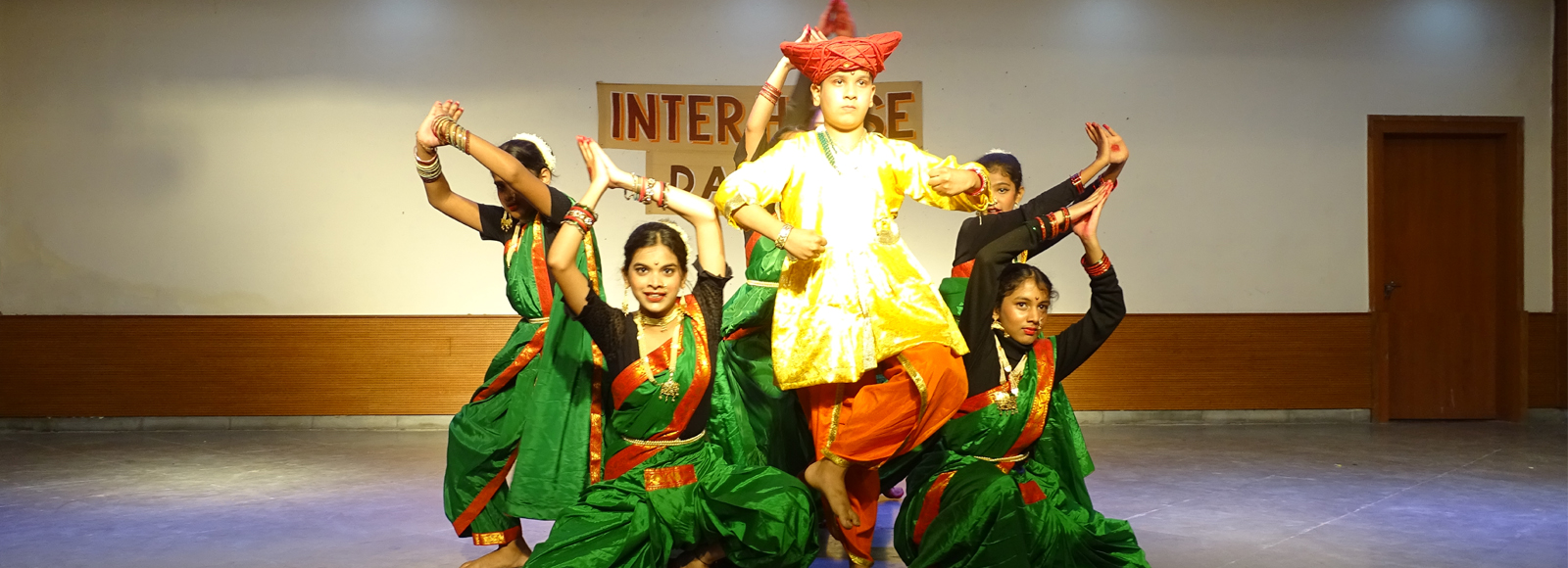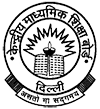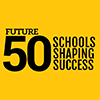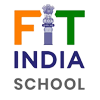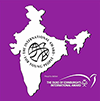“ One language sets you in a corridor for life. Two languages open every door along the way.”- Frank Smith
The English curriculum followed in the Middle School is greatly inspired by Cambridge Secondary 1. The curriculum is presented in seven content areas. Listening, Speaking, Reading, Writing, Literature, Grammar and Phonics, Spelling and Vocabulary.
In grades VI to VIII, the focus under Phonics, Spelling And Vocabulary is to enable the child to spell correctly, increase knowledge of word families, roots, derivations, morphology and regular spelling patterns; learn a range of vocabulary appropriate to their needs and use words with precision in speech and writing. Reading includes reading of fiction, non-fiction and poetry texts using a range of strategies such as skimming and scanning in order to develop and enhance conceptual understanding, decoding, inferring and interpreting. Writing incorporates different ways of generating, organising and shaping ideas, using a range of planning formats or methods, exploring some of the key linguistic and literary techniques used by writers, and beginning to use them to write, inform, explain, describe, argue, persuade and comment. Grammar is not dealt with in isolation. It is contextually related with all other areas of language, especially Literature. The focus is on enabling the child to be self generational in applying the conventions of grammar and using integrated structures with accuracy and fluency. Graded Literature over a span of 3 years helps children to appreciate literature of different genres while learning to understand and apply the terms ‘image’, ‘simile’, ‘metaphor’, ‘onomatopoeia’, ‘setting’ and ‘genre’ in their written responses. Under Speaking and Listening the focus is towards enabling the child to communicate across a wide spectrum and make notable contributions to group discussions while developing the ability to listen courteously to others.
’हिंदी चिरकाल से ऐसी भाषा रही है जिसने मात्र विदेशी होने के कारण किसी शब्द का बहिष्कार नहीं किया।’ - डॉ. राजेंद्र प्रसाद
कक्षा छः में विद्यार्थी पाठ्यपुस्तक के माध्यम से विभिन्न लेखकों के लेख, कहानियाँ, संस्मरण, नाटक पढ़ेंगे तथा शब्द - ज्ञान से समृद्ध होंगे। गद्य के अतिरिक्त पद्य यानी महान् कवियों द्वारा लिखी कविताओं के मर्म को जानेंगे, उसका अर्थ व भाव ग्रहण करेंगे। साहित्य के साथ - साथ व्याकरण द्वारा भाषा के मूल ज्ञान का विकास करेंगे। भाषा, व्याकरण, बोली, लिपि को जानेंगे। शब्दों की उत्पत्ति, बनावट उनके भेदों का ज्ञान प्राप्त करते हुए संज्ञा , सर्वनाम, क्रिया, कर्म, कारक, काल, अव्यय शब्दों, पर्यायवाची, विलोम, अनके शब्दों के लिए एक शब्द, मुहावरे, लोकोक्तियाँ, उपसर्ग, प्रत्यय, जानकर उनकी पहचान व प्रयोग करना सीखेंगे । पत्र - लेखन, निबंध व अनुच्छेद - लेखन द्वारा अपने विचारों को शब्दों में पिरोकर अभिव्यक्ति करना सीखेंगे। सहायक पुस्तक भी पढ़ाई जाएगी, जो उनके पौराणिक - ज्ञान को समृद्ध करेगी व पठन रुचि का विकास करेगी।
कक्षा सात का स्तर छः की अपेक्षा उच्च रहेगा। यहाँ विद्यार्थी पाठ्यपुस्तक में लेख, कहानियों, कविताओं आदि के अतिरिक्त रेखाचित्र, निबंध व साक्षात्कार भी पढ़ेंगे जिसके माध्यम से विद्यार्थियों में संवाद - लेखन शैली के साथ - साथ साक्षात्कार लेखन - शैली के गुण भी समाहित होंगे। महान् लेखकों के रेखाचित्र से अवगत होंगे तथा स्वयं भी लिखने का प्रयास करेंगे। विभिन्न क्षेत्रों व देशों की कहानियाँ पढ़कर भाषा की बारीकी समझेंगे तथा उनमें मानवीय गुण भी विशुद्ध होंगे। सद्विचारों, व्यावहारिक - सामंजस्य, नैतिक - मूल्य, संवेदनशीलता , पशु - पक्षी - मनोभावों से ओतप्रोत पाठ ग्रहण करेंगे। व्याकरण के अंतर्गत जो कक्षा छः में ज्ञान प्राप्त किया, उसी की पुनरावृत्ति तथा उन्हीं विषयों को गहनता (थोड़ी अधिक) से पढ़ेंगे तथा नया विषय संधि पढे़ंगें, जो संधियुक्त शब्द समझने में सहायक रहेगा। भाषा - शुद्धता व स्पष्टता पर और अधिक अधिकार प्राप्त करेंगे। सहायक -पुस्तक भी पढ़ेंगे जो उनके पौराणिक व ऐतिहासिक ज्ञान को समृद्ध करेगी और इससे पठन - रुचि का विकास स्वतः होगा। शब्द - ज्ञान भण्डार भी बढे़गा।
कक्षा आठ में विद्यार्थी गद्य के अंतर्गत विभिन्न विधाओं को समझेंगे तथा कहीं गंभीर, कहीं हास्य तो कहीं करुण कहानियों, लेखों, संस्मरण पढ़ते हुए साहित्यिक ज्ञान को पुष्ट करेंगे। पद्य के अंतर्गत प्राकृतिक व देशभक्ति से सराबोर कविताएँ तथा भक्तिकाल के पद और साखियों का आनंद लेते हुए पद्यात्मक ज्ञान प्राप्त करेंगे। व्याकरण के अंतर्गत कक्षा छः व सात में पढ़ाए गए विषयों की पुनरावृत्ति तथा काल- भेद को गहराई से जानेंगे। संधि को पुनः पढ़ेंगे व ‘समास’ -(एक नया विषय) समझेंगे, इसके भेद व उदाहरण जानेंगे। सहायक - पुस्तक भी पढ़ेंगे तथा सुप्रसिद्ध लेखकों की कहानियों से अवगत होंगे, जिसके माध्यम से देश के अंतर्गत बोले जाने वाले नए - नए शब्दों से परिचित होंगे। पठन - रुचि का विकास स्वतः होगा।
Students in grade VI standard begin understanding the abstract nature of mathematics while developing the ability to form their own concepts. Topics include: knowing numbers, playing with numbers, whole numbers, negative numbers &integers, fractions , introduction to algebra , ratio & proportion , basic geometrical ideas, understanding elementary 2-D and 3-D shapes , symmetry , constructions (using straight edge scale,protractor, compasses),concept of perimeter and introduction to area, pictograph , making bar graphs for given data and interpreting bar graphs.
In grade VII, topics like integers, fractions & decimals, geometry and symmetry have been presented by linking them with their introductory parts studied in 6th standard. Topics include: integers, fractions & rational numbers, powers, algebraic expressions, ratio & proportion (simple interest , percentage) , understanding shapes , properties of triangles , reflection and rotational symmetry , representing 3-D figures in 2-D figures , congruence, construction of triangles, area of a square, rectangle, triangle, parallelogram and circle, constructing bar graphs , mean, median and mode of ungrouped data and introduction to probability.
Grade VIII is the bridge to Grade IX where students deal with more formal mathematics. Topics include: rational numbers , laws of exponents with integral powers, squares, square roots, cubes, cube roots , applications on percentages, profit & loss, overhead expenses, discount, tax, simple and compound interest , direct variation , inverse variation , time & work problems ,properties of quadrilaterals ,verifying Euler’s relation , construction of quadrilaterals ,area of a trapezium and a polygon , volume of a cube, cuboid and cylinder , surface area of a cube, cuboid, cylinder, reading bar-graphs, arranging ungrouped data into groups, constructing and interpreting bar-graphs, simple pie charts ,probability and introduction to graphs.
The aim and objective of teaching Science at Middle School level is to stimulate interest in nature and the physical and social environment. An appreciation of nature and its sources; the development of the powers of observation, exploration, classification and systematic thinking; the development of the child's powers of creative and inventive faculties, with productive and healthy habits.
Since curriculum for Grades VI to VIII is open, we use those Cambridge books which facilitate both theoretical and practical learning .
In Grade VI science, the students explore the Earth & beyond, Material properties, Material changes, Forces, Energy plants, Humans, Living things in their environment, Variation & Classification.
In Grade VII science , the students focus on Sound, Light, Diet, Physiology (i.e. digestion, circulation, respiration & reproduction), Drugs & disease, Separation techniques & Chemical reactions.
In Grade VIII, science covers Human influences (pollution), Rates of reaction, The reactivity series, Energy changes, Making salts, Adaptation & survival, Energy flow, Electricity & energy .
Grade VI Social Science familiarizes the students with major developments in history. It helps them understand the skills and knowledge of hunter gatherers, early domestication, life in the first cities and the use of archaeological material to reconstruct social and economic histories. It will enable them to understand the unique place of the earth in the solar system, the two motions of the earth and their effects, basic skills of map reading, inter-relationship of the realms of the earth, physiographic divisions of India etc. The students will also be able to appreciate various forms of diversity in their everyday environments, understand how prejudice can lead to discrimination, difference between diversity and inequality, the Constitution, why government is required, the need for universal adult franchise, the key elements that influence the functioning of democracy, the workings of the Panchayati Raj and its importance.
In grade VII, Social Science enables students to trace the patterns of political developments and military conquests; understand the development of political institutions and relationship among foreign rulers. They are also acquainted with the introduction of new administrative reforms; range of material, skills and styles used to build; the origins and histories of towns; the major religious ideas and practices; the development of regional cultural forms, including ‘classical’ forms of dance and music; the new developments of global society, the complex inter-relationship of human and natural environment. The component of social and political life enables students to develop an understanding of the Rule of Law and our involvement with its institutions; the value of the constitution; the idea of equality and dignity of the individual in democracy; the understanding of the process of decision making within state governments.
In grade VIII the students will be able to delineate major developments within their time frame, unravel the story of a trading company becoming a political power, discuss different forms of tribal societies, understand the processes of de-industrialization and industrialization; have an idea of the technologies of weaving and the lives of weavers, discuss how revolts originate and spread; engage with the politics of education and how it is linked to questions of power and cultural identity. Students learn about resources, their variety, location and distribution; understand the importance of resources in our life and the need for a judicious use of resources for sustainable development; conservation of resources; learning about various types of farming and agricultural development in different regions; important types of manufacturing industries and role of human resources in the development of a nation’s economy. They will be familiarized with the role of the Constitution as the primary source of all laws of the country, develop an appreciation of human rights guaranteed in the Constitution, why India chose a parliamentary form of government;, the main elements of our judicial structure, what is meant by ‘marginalized’, gain a critical understanding of social and economic injustices and think about the role of government in the economic sphere.
At Mayoor, a high-quality computer education equips pupils to use computational thinking and creativity to understand and change the world. It is a common belief that irrespective of the careers chosen, the basic knowledge about computers will help students in the long run. We have developed our own syllabus and content using FOSS applications that focuses on teaching core concepts of IT along with learning of other subjects like Maths, Science, English. Middle School curriculum works on the philosophy of ‘Learning by Doing’. The curriculum stresses on IT Concepts , Office Suite, Desktop Publishing, Programming and Database Management.
At the middle stage in class VI to VIII, Desktop Publishing Software like Gimp, Inkscape and Scribus are introduced which facilitate pupils toward the design and production of brochures, newsletters, posters, cards, leaflets, calendar and more. Open Office.org (Calc) is introduced which enable them to create result sheets, time-table and bills by learning various functions and formatting rules. Database using MySQL enables them to create and manage data using various queries. Programming using SmallBasics and NetBeans IDE allows them to learn the concept of application designing using graphical user interface. Pupils are able to understand the difference between Front End and Back End environment.
For Homework Schedule – Click Here
For List of Books Prescribed – Click Here
Declaration duly signed by the Principal – Click Here


